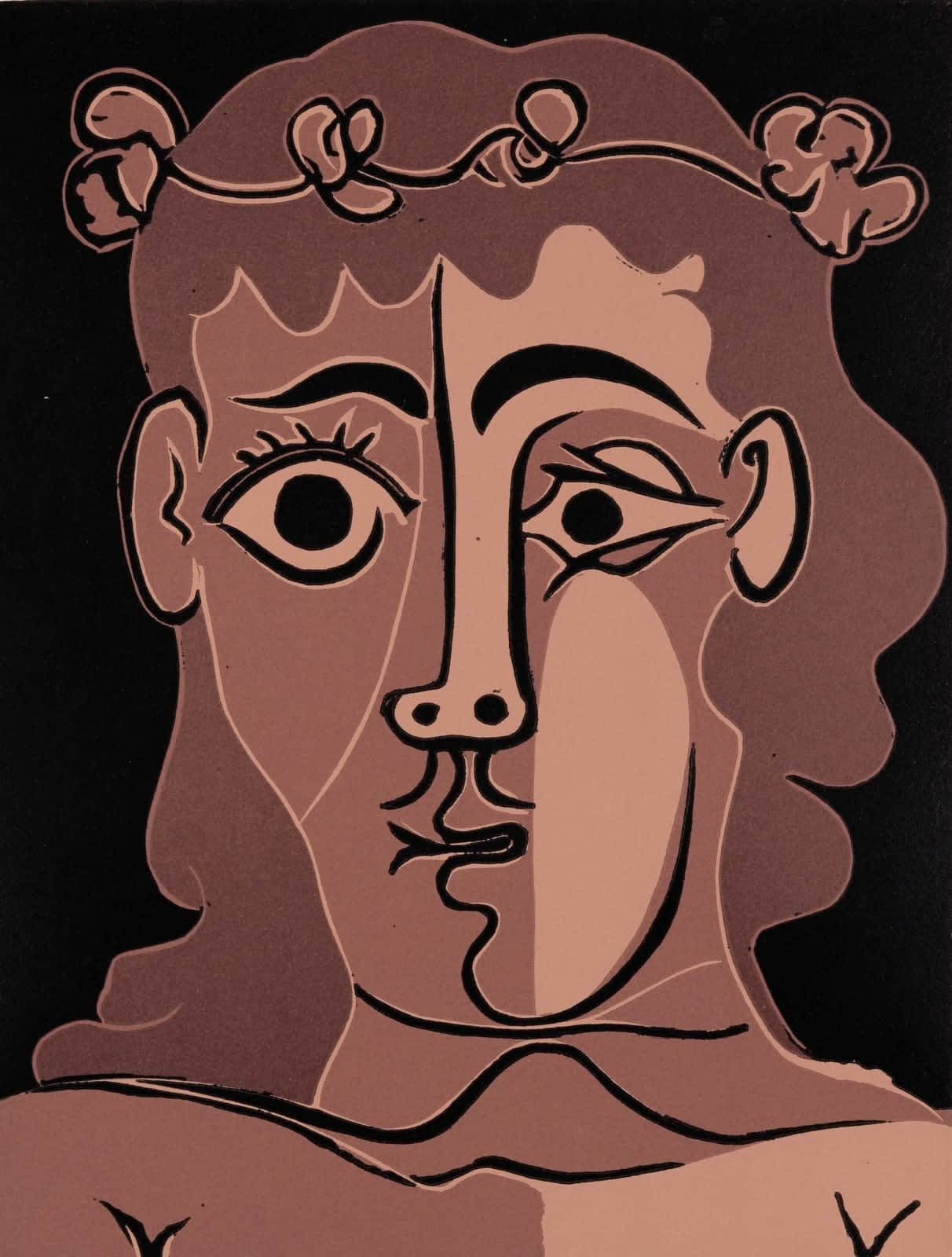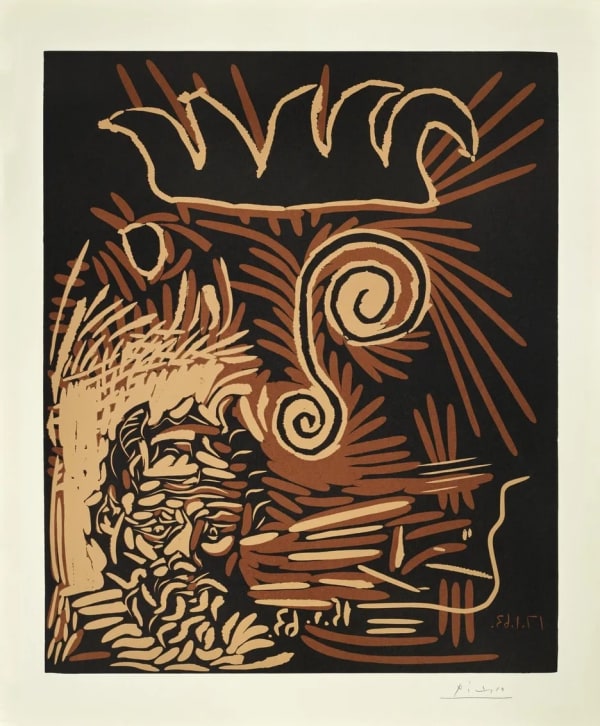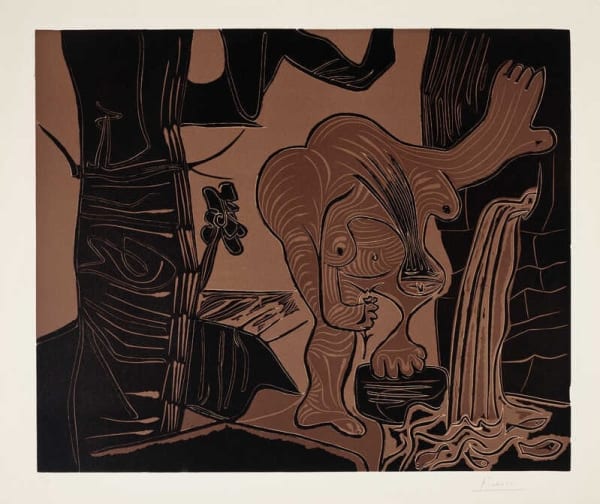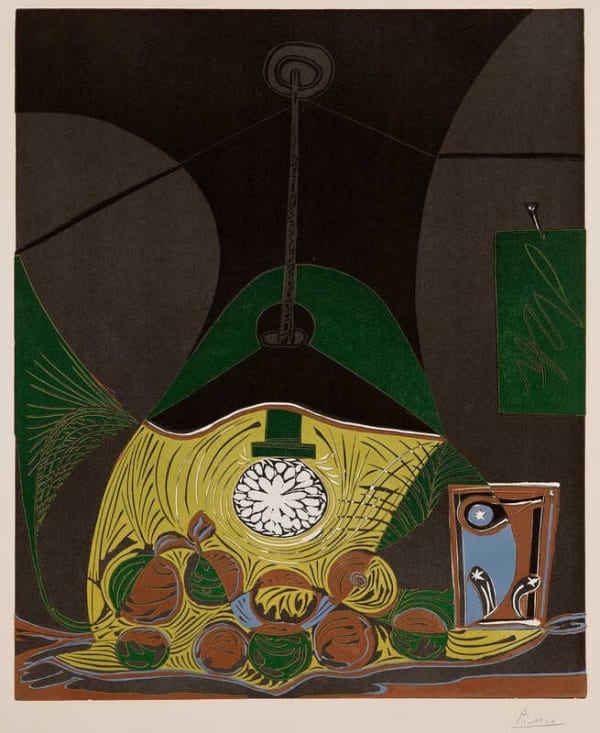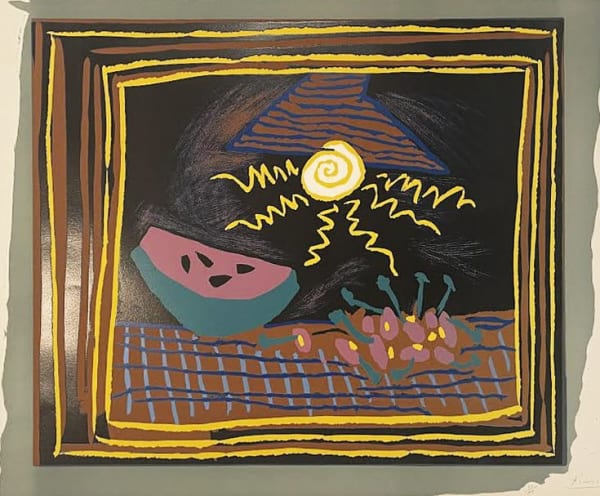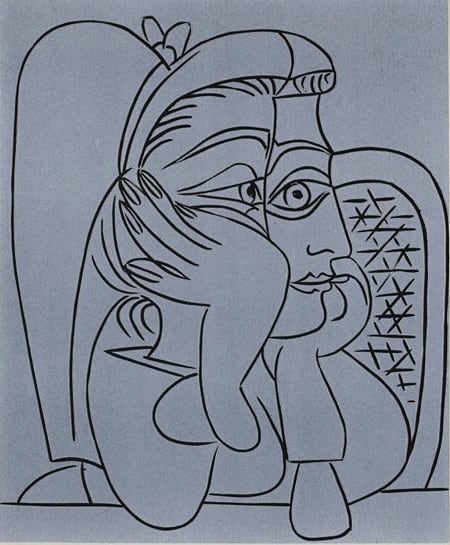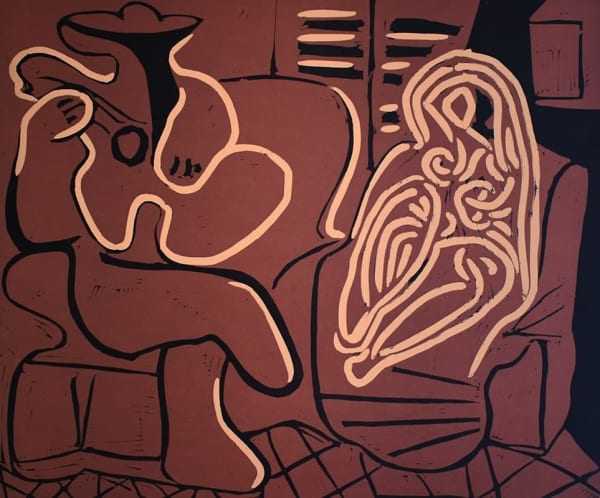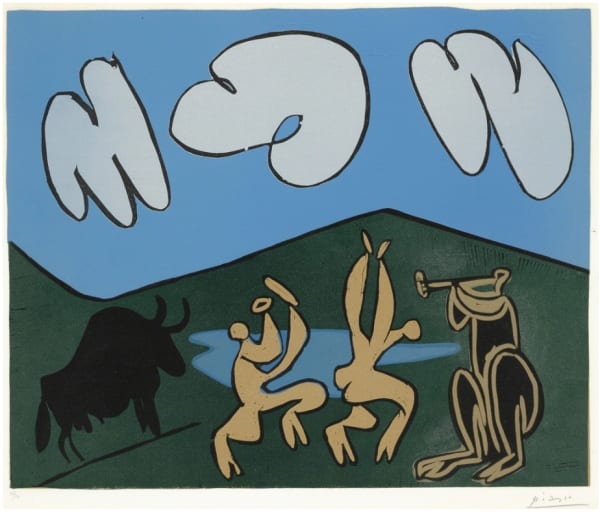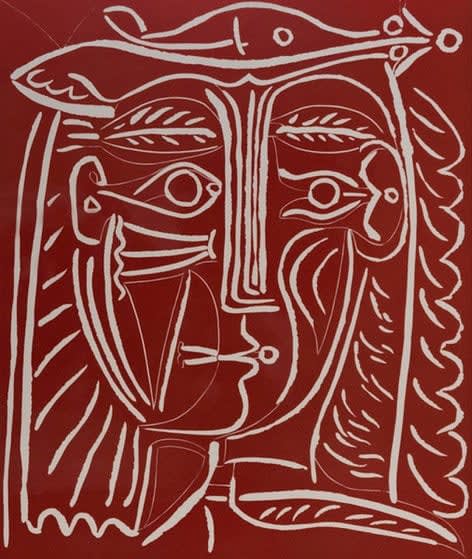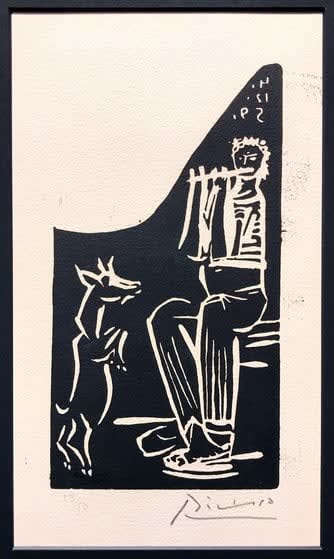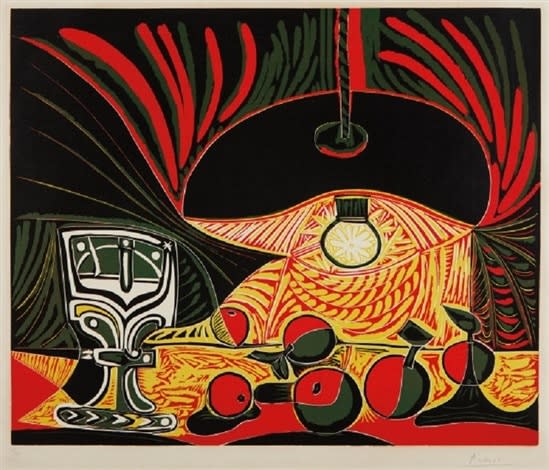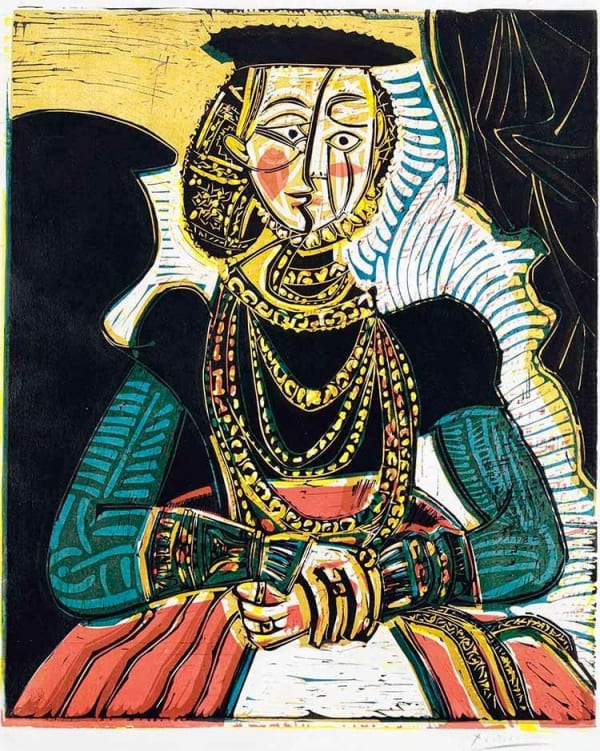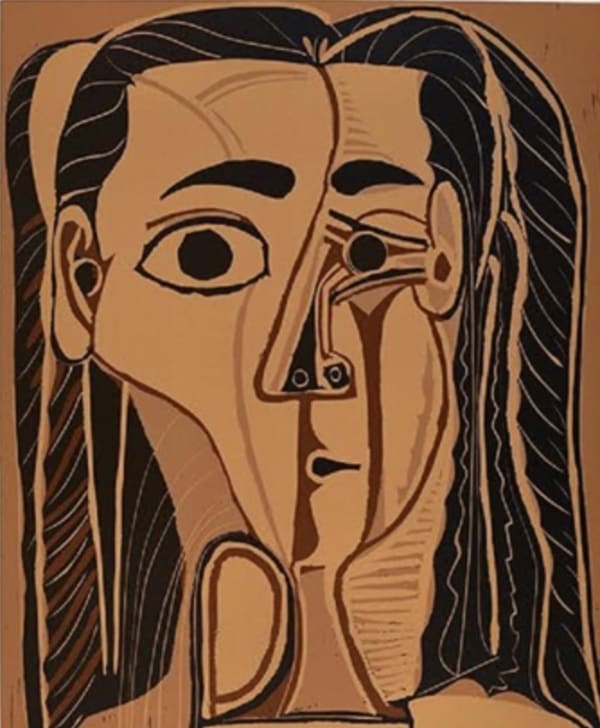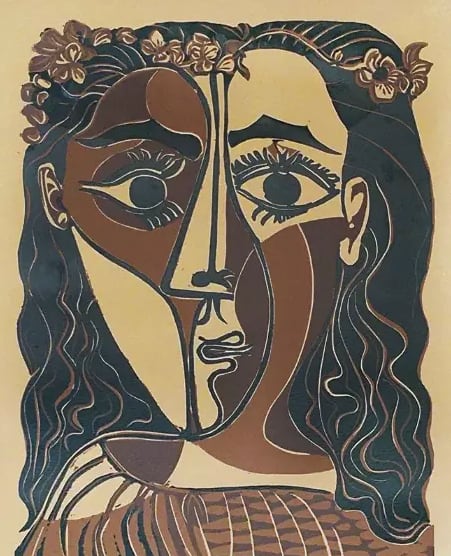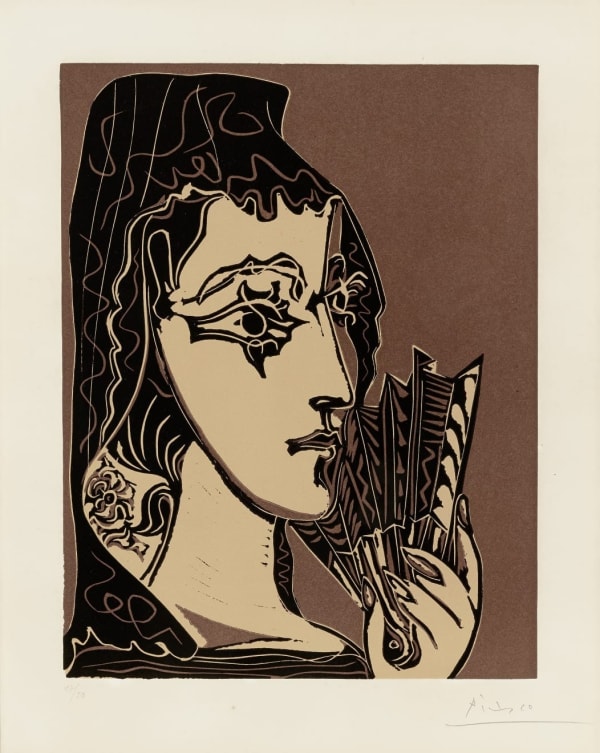-
Artworks

Pablo Picasso
Boy with a Crown of Leaves | Jeune homme couronné de feuillage, 1959Original Hand Signed and Inscribed Linocut in Colours on Arches Wove PaperPaper size: 62.9 x 44.3 cm. / 24.8 x 17.4 in.
Image size: 34.9 x 26.8 cm. / 13.7 x 10.5 in.Edition of 50Series: LinocutCopyright The ArtistThis linocut by Pablo Picasso, Boy with a Crown of Leaves (Jeune homme couronné de feuillage), is a striking example of the artist’s late graphic work, where he harnessed the...This linocut by Pablo Picasso, Boy with a Crown of Leaves (Jeune homme couronné de feuillage), is a striking example of the artist’s late graphic work, where he harnessed the linocut medium with unparalleled boldness to create images that were at once timeless and distinctly modern. Executed on Arches wove paper, this hand-signed and inscribed linocut exemplifies Picasso’s ability to reduce form to its essentials while preserving expressive force and symbolic weight.
By the late 1950s and early 1960s, Picasso had fully mastered the linocut, transforming a relatively humble printmaking method into one of his most powerful artistic tools. Unlike etching or lithography, linocut relies on carving directly into linoleum blocks, demanding both decisiveness and confidence. Picasso took this further by experimenting with the reduction method, cutting and re-cutting the same block for successive colors rather than using multiple plates.In Boy with a Crown of Leaves, the medium’s possibilities are fully realized. The bold flat planes of earthy browns and pinks are sharply juxtaposed with black outlines, creating a graphic clarity that emphasizes both structure and expression. Printed on Arches wove paper, known for its fine texture and resilience, the work carries a luminous, tactile quality that enhances its monumental simplicity.
The portrait is dominated by a frontal face, symmetrically split yet subtly asymmetrical—a hallmark of Picasso’s modernist language. The large, wide-open eyes convey both innocence and intensity, while the stylized lips and simplified nose reduce the features to their most essential contours. The crown of leaves, resting delicately across the boy’s head, connects the portrait to themes of antiquity, youth, and vitality.The play between flat color and expressive line is central to the work. Picasso uses sharp contrasts to model the face without shading or depth, achieving sculptural presence through the tension of curves, angles, and bold outlines. The simplicity of form recalls both archaic portraiture and modern abstraction, situating the image at the intersection of tradition and innovation.
The subject of a crowned youth resonates with Picasso’s long-standing engagement with classical themes. Since the 1920s, he had returned repeatedly to Greco-Roman motifs—gods, muses, satyrs, and crowned figures—often reinterpreting them in contemporary forms. Here, the boy crowned with leaves recalls classical imagery of victory, fertility, and festivity, but rendered with the economy and graphic clarity of Picasso’s linocut style.This balance of myth and modernity is emblematic of Picasso’s late period. At a time when abstraction and minimalism were dominating postwar art, Picasso reaffirmed figuration but in radically reduced, graphic terms. The linocut provided the perfect medium for this dialogue, allowing him to merge ancient symbolism with a bold modernist visual language.
What sets this work apart is how it reflects Picasso’s unparalleled command of linocut. With only a handful of colors and a few decisive cuts, he conjures a figure of immense presence. The technical precision required by the reduction method—where each stage of cutting eliminates previous surfaces forever—shows not only his confidence but also his ability to innovate within strict constraints.This print is a testament to Picasso’s restless creativity. Having mastered etching, aquatint, lithography, and ceramics, he turned to linocut in his later years and produced some of the most iconic prints of the 20th century, proving once again that no medium was too modest to become a vessel for his genius.
For more information or to buy Bouquet à la pomme by Pablo Picasso, contact our galleries using the form below.
Boy with a Crown of Leaves (Jeune homme couronné de feuillage) encapsulates Picasso’s late style: bold, economical, and deeply rooted in both classical tradition and modern innovation. Through the linocut medium, he distilled portraiture to its essence—flat planes, stark contrasts, and symbolic clarity—while imbuing it with a timeless vitality. It is not just a portrait of a crowned youth but also a meditation on the enduring power of myth and the endless capacity of line and form to reinvent human expression.%3Cdiv%20class%3D%22artist%22%3EPablo%20Picasso%3C/div%3E%3Cdiv%20class%3D%22title_and_year%22%3E%3Cspan%20class%3D%22title_and_year_title%22%3EBoy%20with%20a%20Crown%20of%20Leaves%20%7C%20Jeune%20homme%20couronn%C3%A9%20de%20feuillage%3C/span%3E%2C%20%3Cspan%20class%3D%22title_and_year_year%22%3E1959%3C/span%3E%3C/div%3E%3Cdiv%20class%3D%22medium%22%3EOriginal%20Hand%20Signed%20and%20Inscribed%20Linocut%20in%20Colours%20on%20Arches%20Wove%20Paper%3C/div%3E%3Cdiv%20class%3D%22dimensions%22%3EPaper%20size%3A%2062.9%20x%2044.3%20cm.%20/%2024.8%20x%2017.4%20in.%3Cbr/%3E%0AImage%20size%3A%2034.9%20x%2026.8%20cm.%20/%2013.7%20x%2010.5%20in.%3C/div%3E%3Cdiv%20class%3D%22edition_details%22%3EEdition%20of%2050%3C/div%3E%3Cdiv%20class%3D%22series%22%3E%3Cspan%20class%3D%22artwork_caption_prefix%22%3ESeries%3A%3C/span%3E%20Linocut%3C/div%3ERelated artworks-
 Pablo PicassoTwo Women by the Window | Deux femmes près de la fenêtre, 1959
Pablo PicassoTwo Women by the Window | Deux femmes près de la fenêtre, 1959 -
 Pablo PicassoWoman Reclining and Man with a Guitar | Femme couchée et homme à la guitare, , 1959
Pablo PicassoWoman Reclining and Man with a Guitar | Femme couchée et homme à la guitare, , 1959 -
 Pablo PicassoJacqueline au chapeau de paille, 1962
Pablo PicassoJacqueline au chapeau de paille, 1962 -
 Pablo PicassoLe Vieux bouffon, 1963
Pablo PicassoLe Vieux bouffon, 1963 -
 Pablo PicassoHomme au batôn / Le Vieux bouffon, 1963
Pablo PicassoHomme au batôn / Le Vieux bouffon, 1963 -
 Pablo PicassoFemme nue à la source, 1963
Pablo PicassoFemme nue à la source, 1963 -
 Pablo PicassoNature morte à la suspension, 26 mars, 1962
Pablo PicassoNature morte à la suspension, 26 mars, 1962 -
 Pablo PicassoTaureau et Picador, 1959
Pablo PicassoTaureau et Picador, 1959 -
 Pablo PicassoFemme au Chapeau (Portrait de Jacqueline au chapeau de paille multicolore)., 1962
Pablo PicassoFemme au Chapeau (Portrait de Jacqueline au chapeau de paille multicolore)., 1962 -
 Pablo PicassoLe Déjeuner sur l'herbe d'aprés Edouard Manet. (The Luncheon on the Grass after Edouard Manet), 1954
Pablo PicassoLe Déjeuner sur l'herbe d'aprés Edouard Manet. (The Luncheon on the Grass after Edouard Manet), 1954 -
 Pablo PicassoNature Morte a la Pasteque, 1962
Pablo PicassoNature Morte a la Pasteque, 1962 -
 Pablo PicassoLe Vieux Roi (B. 1152) (The Old King) , 1963
Pablo PicassoLe Vieux Roi (B. 1152) (The Old King) , 1963 -
 Pablo PicassoFemme Accoudée (Bloch 922) , 1959
Pablo PicassoFemme Accoudée (Bloch 922) , 1959 -
 Pablo PicassoLes vendangeurs, 1959
Pablo PicassoLes vendangeurs, 1959 -
 Pablo PicassoL'Aubade, avec Femme Accoudee, 1959
Pablo PicassoL'Aubade, avec Femme Accoudee, 1959 -
 Pablo PicassoAubade, with a Woman in an Armchair | L'aubade, avec femme dans un fauteuil, 1959
Pablo PicassoAubade, with a Woman in an Armchair | L'aubade, avec femme dans un fauteuil, 1959 -
 Pablo PicassoJacqueline au Bandeau, 1962
Pablo PicassoJacqueline au Bandeau, 1962 -
 Pablo PicassoWatermelon Still Life, 1962
Pablo PicassoWatermelon Still Life, 1962 -
 Pablo PicassoDeux Femmes Prés de la Fenêtre , 1959
Pablo PicassoDeux Femmes Prés de la Fenêtre , 1959 -
 Pablo PicassoBacchanale au Hibou (bloch 938), 1959
Pablo PicassoBacchanale au Hibou (bloch 938), 1959 -
 Pablo PicassoBacchanale au Taureau Noir (Bloch 935), 1959
Pablo PicassoBacchanale au Taureau Noir (Bloch 935), 1959 -
 Pablo PicassoTête de Femme au Chapeau , 1962
Pablo PicassoTête de Femme au Chapeau , 1962 -
 Pablo PicassoFaune et Chévre, 1959
Pablo PicassoFaune et Chévre, 1959 -
 Pablo PicassoPortrait de Femme a la Fraise et au Chapeau , 1962
Pablo PicassoPortrait de Femme a la Fraise et au Chapeau , 1962 -
 Pablo PicassoL'Etreinte (Bloch 1150), 1963
Pablo PicassoL'Etreinte (Bloch 1150), 1963 -
 Pablo PicassoNu Assis, 1962
Pablo PicassoNu Assis, 1962 -
 Pablo PicassoPortrait De Jacqueline (Bloch 923), 1959
Pablo PicassoPortrait De Jacqueline (Bloch 923), 1959 -
 Pablo PicassoPortrait de Jacqueline Au Chapeau De Paille Fleuri, 1962
Pablo PicassoPortrait de Jacqueline Au Chapeau De Paille Fleuri, 1962 -
 Pablo PicassoLa Pique en Rouge et Jaune (The Bullfight in Red and Yellow), 1959
Pablo PicassoLa Pique en Rouge et Jaune (The Bullfight in Red and Yellow), 1959 -
 Pablo PicassoJacqueline au Bandeau, 1962
Pablo PicassoJacqueline au Bandeau, 1962 -
 Pablo PicassoNature Morte Au Verre Sous La Lampe, 1962
Pablo PicassoNature Morte Au Verre Sous La Lampe, 1962 -
 Pablo PicassoBuste de Femme d'après Cranach le Jeune, (Bloch 859), 1958
Pablo PicassoBuste de Femme d'après Cranach le Jeune, (Bloch 859), 1958 -
 Pablo PicassoPortrait de Jacqueline Accoudée, 1959
Pablo PicassoPortrait de Jacqueline Accoudée, 1959 -
 Pablo PicassoGrande Tete De Femme (Bloch 1069), 1962
Pablo PicassoGrande Tete De Femme (Bloch 1069), 1962 -
 Pablo PicassoPetite Tête de Femme Couronnée, `962
Pablo PicassoPetite Tête de Femme Couronnée, `962 -
 Pablo PicassoPortrait de Jacqueline en Carmen (L'Espagnole) , 1962
Pablo PicassoPortrait de Jacqueline en Carmen (L'Espagnole) , 1962
-
Join our mailing list
* denotes required fields
We will process the personal data you have supplied in accordance with our privacy policy (available on request). You can unsubscribe or change your preferences at any time by clicking the link in our emails.
This website uses cookies
This site uses cookies to help make it more useful to you. Find out more about cookies.
